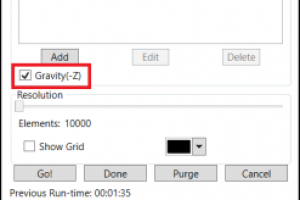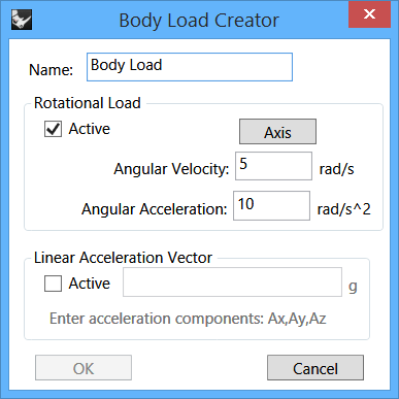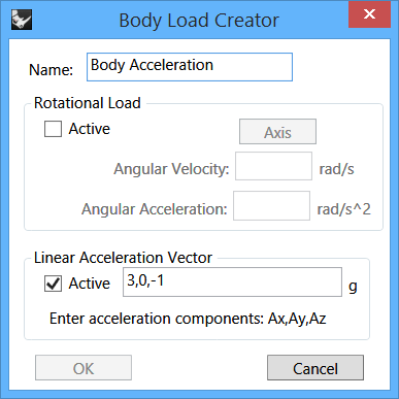Table of Contents
Body Loads
Body loads comprise forces that are distributed over a solid volume. Probably the most familiar of these is the gravitational force acting on a mass to give it weight. Simple gravitational loads are applied in the Specify tab using the Gravity checkbox. Rotational body loads and general linear acceleration loads are applied by choosing [Add] in the Loads group. Followed by the Body option at the command line.
Gravitational Loads
Gravitational loads are the simplest to apply. Simply check the [ ] Gravity checkbox to apply a gravitational load and simulate the model under its own weight. Gravitational loads applied in this manner act in the -Z direction with a magnitude corresponding to Earth's surface gravitation. More complex gravitation scenarios may be simulated using linear acceleration loads. If the Gravity box is checked, the gravitational load is added to any other loads being applied.
Rotational Body Loads
Rotational body loads are applied by choosing [Add] in the Loads group of the Specify tab. Choose the the Body option at the command line to bring up the Body Load Creator dialog.
A rotational body load consists of 2 components: angular velocity and angular acceleration; specified using the following steps:
- Enable rotational body loads by checking the [ ] Active checkbox in the Rotational Load group.
- Click [Axis] and choose an axis (a ray) of rotation by specifying an origin for the axis followed by a point on the axis (the ray's direction).
- Specify the angular velocity and angular acceleration in the entry boxes.
- Click [OK] to dismiss the dialog and apply the load to the model.
The direction of the rotation is determined using the right hand rule: using your right hand, point your thumb in the direction of the axis. A positive angular acceleration would simulate moving the restraints in the direction the fingers of your right hand would wrap around the axis. The body will tend to deflect in the opposite direction. The radial deflection due to angular velocity is independent of rotational direction.
The rotational body load is added to the body loads due to gravity and linear acceleration.
Linear Acceleration Body Loads
Linear acceleration loads are applied by choosing [Add] in the Loads group of the Specify tab. Choose the the Body option at the command line to bring up the Body Load Creator dialog.
Linear acceleration vector loads are specified by entering the components of a linear acceleration vector in fractions of Earth's g. It is added to the body loads due to gravity and rotation.
- Enable linear acceleration vector body loads by checking the [ ] Active checkbox in the Linear Acceleration Vector group.
- Specify the x, y, z components in the entry box in the form Ax,Ay,Az.
- Click [OK] to dismiss the dialog and apply the load to the model.
The body's response to the linear acceleration is simulated as if the restraints are accelerated in the specified direction. The distributed mass of the body will tend to deflect in the opposite direction.



